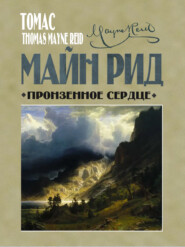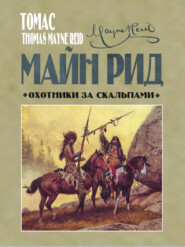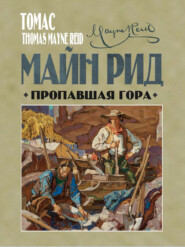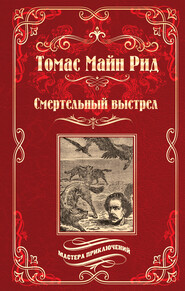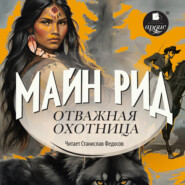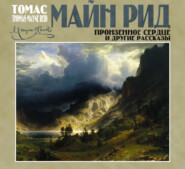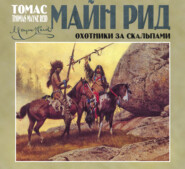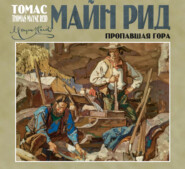По всем вопросам обращайтесь на: info@litportal.ru
(©) 2003-2024.
✖
The Cliff Climbers
Настройки чтения
Размер шрифта
Высота строк
Поля
They were tall, long-legged, slender-bodied creatures, and easily distinguished by both Karl and Caspar, as belonging to the family of rallidae or water-hens.
There could be no doubt that they were walking on the water – sometimes slowly, at other times in a quick run – and, what was even more unaccountable than this, they were seen at times to stand still upon the water! Ay, and, what might be considered more surprising still, they performed this aquatic feat upon only one leg!
The thing might have been more mysterious, had not Karl from the first suspected the reason why the laws of specific gravity appeared to be thus contradicted. He suspected the existence of some plant, whose leaves, lying spread on the surface, perhaps offered a footing for the birds, sufficiently firm to support the weight of their bodies.
The botanist was only reasoning from remembrance. He had lately read the account published but a few years before of the discovery of the gigantic water-lily of tropical America – the Victoria Regia– and remembered how its discoverers had spoken of large birds of the crane family making their perch upon its huge leaves, and thus supported, playing about over the surface of the water, as if the firm earth had been under their feet.
With these facts fresh in his memory, Karl conjectured that the water-hens seen by him and his companions were supported on a similar pedestal, and playing themselves on a like platform. His conjecture proved correct: for on visiting the place shortly after, the broad orbicular leaves of the Nelumbium speciosum were perceived – almost as large as those of their South American congener.
Other interesting points relating to the great lily growing in the Himalayan lake, Karl had mentioned from time to time to his companions: for he knew that the Nelumbium speciosum was the celebrated Pythagorean bean mentioned in the writings of the Greeks – more especially by Herodotus and Theophrastes.
It is described by these writers as growing plentifully in Egypt; and no doubt was cultivated in that country in their day; though it is not known there at the present time. It is found represented on the Egyptian sculptures, and so accurately has it been described by the Greek writers, as to leave no doubt as to the identification of the species.
It is one of the plants supposed to be the celebrated “lotus” of antiquity; and this supposition is probable enough: since not only its succulent stalk, but its seeds or “beans,” have been eaten in all times by the people in whose country it grows. It is a food that produces a strengthening effect upon the system; and is also very refreshing in cases of thirst. The Chinese call it “Lienwha,” and its seeds with thin slices of its root, mixed with the kernels of apricots and walnuts, and placed between alternate layers of ice, constituted one of the select dishes offered by the great mandarins to the British ambassadors on the visit of the latter to the Celestial Empire.
These people store up the roots of the lienwha for winter use – preserving them in a pickle of salt and vinegar. The Japanese also make use of the plant as an esculent; and it is, moreover, regarded by them as sacred to their divinities – the images of which are often represented seated upon its large leaves.
The flowers of the Nelumbium speciosum when in full bloom, give out a most fragrant odour – somewhat resembling that of anise; while the seeds, shaped like acorns, have a flavour equal in richness and delicacy to that of the finest almonds.
Chapter Fifty Five.
An aquatic harvest
It was not upon that occasion that Karl communicated to his companions all these interesting facts in relation to the great lily. Many of them he had made known long before – especially that the seeds of the plant were eatable; and both Caspar and Ossaroo had often proved to their own satisfaction that they were something more than eatable – in short, a great delicacy.
It was from a knowledge of this fact that the thoughts of all three were now turned upon the lilies – whose huge roseate corollas, no longer seen glistening above the surface of the water, proclaimed that the “beans” were ripe, and ready for “shelling.”
The three were about starting from the hut to reap this aquatic harvest – which, judging from the quantity of seed-pods that appeared above the surface, promised to be abundant.
Each had provided himself with a rush basket – which the shikaree had woven, during the long winter nights, for other purposes; but as they were of just the size and shape to hold the Pythagorean beans they were now to be employed in that capacity.
Both Karl and Caspar had rolled up their trowsers to mid-thigh; so as not to wet them while wading among the lilies; but Ossaroo, not being provided with any nether garment entitled to the name of trowsers, had simply tucked up the skirt of his cotton tunic, making it fast under his girdle.
In this guise all three proceeded round the shore of the lake, to that side where they would be nearest the bed of lilies. The water-hens, seeing them make their approach, rose from their perch upon the leaves, and fluttered off to seek a more secure shelter among the sedge.
The aquatic gleaners at once waded in; and commenced picking off the pods, and shelling them into their rush baskets. They had been there before, and knew there was no danger in the depth of the water.
They had nearly filled their respective sacks with the Pythagorean beans, and were meditating a return to dry land, when a dark shadow passing over the tranquil surface of the lake – closely followed by another of similar size and shape – attracted their attention.
All three saw the shadows at the same instant of time; and all simultaneously looked up to ascertain what sort of creatures were casting them. In the sky above they beheld a spectacle, calculated to inspire them with feelings of a strange interest.
Right above the lake, and also over their heads, a brace of large birds was circling in the air. Each was borne up by a pair of huge wings full five yards from tip to tip; while from the body, between, a neck of enormous length was extended horizontally – prolonged into a tapering-pointed beak, in shape like the seed-pistil of a pelargonium.
Their beaks might well have been compared to the pistil of a pelargonium; or rather the latter should be assimilated to them; since it is from this species of birds, the flower has derived its botanical cognomen.
The birds were storks. Not the ordinary Ciconia, that makes its home among the Hollanders – or finds a still more welcome hospitality on the roof-tree of the Hungarian by the plains of the Puszta– but a stork of far grander dimensions; in short, a stork that is the tallest of his tribe – the Adjutant.
On looking up, Karl recognised the species; so did Caspar, and at a glance. It required no lengthened scrutiny – no profound knowledge of natural history, to identify the noted adjutant. It only needed to have seen him before either in propria persona, or in a picture; but both brothers had seen specimens of the bird, in full flesh and feather, on the plains of India – in the environs of Calcutta itself.
As to the shikaree, was it likely he should be mistaken about the character of those winged giants – those tall scavengers he had seen thousands of times stalking pompously along the sandy shores of the sacred Ganges? It was not possible for him, to have a doubt about the identity of the birds, who were now throwing their shadows over that lone lake of the Himalayas. He had no doubt. The very certainty that the birds above him were the gigantic cranes of the Ganges – the sacred birds of Brahma – caused him to utter a sort of frenzied shout, and at the same time, dropping his “sack of beans” into the water!
He needed not to look at the colour of the birds, to note that they were brown black above, and white underneath. The naked vulture neck with its pouch-like appendage of brick-red hue; the silken feathers of bluish white under the tail – those precious plumes well-known and worn by the ladies of many lands under the appellation of marabout feathers– all were recognised at a glance.
Even quicker than either of his youthful comrades had the Hindoo identified the birds. A single glance sufficed, and simultaneously with that glance had the cry fallen from his lips, and the sack of Pythagorean beans from his grasp.
The birds were flying slowly, and to all appearance laboriously: as if wearied of wing. They appeared to be in search of some roost on which to repose themselves.
That they had entered the valley with this intention was made evident a few moments after: for having made a circuit round the little lake, both at the same instant ceased to ply their long pinions, and drawing their wings suddenly in to their bodies, they settled down upon the shore.
The spot upon which they had chosen to alight was the prominence terminating a little peninsula that protruded out almost to the bed of lilies, and from which the three waders had themselves descended into the water. As the latter now stood knee-deep among the aquatic plants, they were distant not more than twenty paces from the point of this peninsula.
The storks, after alighting, stood upon the shore in erect attitudes – apparently as unconcerned about the presence of our three adventurers, as if the latter were only overgrown stalks of the Pythagorean bean – utterly incapable of doing them an injury.
Chapter Fifty Six.
The adjutants
The brace of gigantic birds, that had thus alighted by the shore of the little lake, were, to say the least, uncouth creatures; for the whole ornithological world might be ransacked without finding a greater oddity than the adjutant.
In the first place, it stands six feet upon its long, straight shanks; though its actual length, measuring from the tip of its bill to the termination of its claws, is full seven and a half. The beak, of itself, is over a foot in length, several inches in thickness, with a gibbous enlargement near the middle, and having both mandibles slightly curved downwards.
The spread of a full-grown adjutant’s wing is fifteen feet, or five yards, from tip to tip – quite equalling in extent either that of the Chilian condor or the “wandering” albatross.
In colour the adjutant may be described as black above and white underneath, neither (that) being very pure. The upper plumage is a dirty brownish black; while the belly and under parts present a dull white appearance, – partly from an admixture of greyish feathers, but also from the circumstance that the bird is usually bedaubed with dirt – as mud from the marshes, where it feeds, and other filth, in which it seems to take delight. But for this foulness, the legs of the adjutant would be of a dark colour; but in the living bird they are never seen of the natural hue – being always whitened by the dust shaken out of its plumage, and other excrement that attaches itself to the skin.
The tail is black above and white underneath – more especially the under coverts, which are of a pure white. These last are the plumes so highly prized under the name of “marabout feathers,” an erroneous title, arising through a mistake – made by the naturalist Temminck in comparing the Indian adjutant with another and very different species of the same genus – the marabout stork of Africa.
One of the distinctive characteristics of the adjutant, or “argala,” as it is better known to the Indians, – and one, too, of its ugliest “features,” – is a naked neck of a flesh-red colour the skin shrivelled, corrugated, and covered with brownish hairs. These “bristles” are more thickly set in young birds, but become thinner with age, until they almost totally disappear – leaving both head and neck quite naked.
This peculiarity causes a resemblance between the adjutant bird and the vultures; but indeed there are many other points of similarity; and the stork may in all respects be regarded as a vulture – the vulture of the grallatores, or waders.
In addition to the naked neck, the adjutant is furnished with an immense dew-lap, or pouch which hangs down upon its breast – often more than a foot in length, and changing from pale flesh colour to bright red, along with the skin of the throat. At the back of the neck is found still another singular apparatus – the use of which has not been determined by the naturalist. It is a sort of vesicular appendage, capable of being inflated with air; and supposed to serve as an atmospheric buoy to assist in sustaining the bird in its flight. The inflation has been observed to take place under exposure to a hot sun; and, therefore, it is natural to infer, that the rarefaction of the air has something to do in causing (the bird to use this organ). As the adjutant often flies to a great height, it is possible that this balloon-like apparatus is necessary to sustaining it in the rarefied atmosphere found at such an elevation. The annual migration of the bird over the lofty chain of the Himalayas might not be possible, or if possible, more difficult, without this power of decreasing the specific gravity of its body.
It is scarce necessary to say that the adjutant – like all birds of the family to which it belongs – is a filthy and voracious feeder; carnivorous in the highest degree; and preferring carrion and garbage to any other sort of food. It will kill and swallow live kind – such as frogs, snakes, small quadrupeds, and birds – the latter not so very small either: since it has been known to bolt a whole fowl at a single “swallow.” Even a cat or a hare can be accommodated with a passage down its capacious gullet; but it will not attempt to kill either one or the other: since, notwithstanding its gigantic size, it is one of the veriest cowards in creation. A child, with a bit of a switch, can at any time chase the adjutant away; and an enraged hen will put it to flight whenever it strays into the neighbourhood of her young brood. It does not retreat, without first making a show of defiance – by placing itself in a threatening attitude – with reddened throat, and beak wide agape, from which latter proceeds a loud roaring, like that of a bear or tiger. All this, however, is mere braggadocio; for, on the enemy continuing the attack, it immediately cools down, and betakes itself to ignominious flight.
Such are a few peculiarities of the gigantic stork, known as the adjutant or argala. It only remains to be added, that there are at least two, perhaps three, other species of storks of very large dimensions – though not so large as this one – that for a long time have been confounded with it. One of these is the marabou; which inhabits the tropical regions of Africa, and which also produces the plumes so much prized in the world of fashion. The feathers of the African species, however, are far less beautiful and valuable than those from the tail of the adjutant; and it is these last that are really best known as marabout feathers, in consequence of the mistake made by Temminck, and propagated by the anatomist Cuvier.
Another great stork – differing both from the argala of Asia and the marabou of Africa – inhabits the Island of Sumatra. It is known to the natives as the “Boorong Cambay;” while in the neighbouring Island of Java is found either a fourth species of these gigantic birds, or the same that belongs to Sumatra.
It is somewhat singular that such creatures should have remained so long unknown to the scientific world. It is not much more than half a century since travellers began to describe them with any degree of exactness; and even at the present time their history and habits have received but very slight elucidation. This is the more surprising when we consider that on the banks of the Ganges – even in Calcutta itself – the adjutant is one of the most common birds – constantly stalking about the houses, and entering the enclosures with as much familiarity, as if it was one of the regular domestics of the establishment!
Its services as a “scavenger” procure for it an immunity from persecution; and it is not only tolerated by the people, but encouraged, in its advances towards fellowship with them; notwithstanding that at times it becomes rather troublesome in its attentions to the young ducklings, chicklings, and other denizens of the farmyard.
Sometimes they are not even contented with such fare as may be found outside; but have been known to enter the bungalow; snatch a smoking joint from the table; and swallow it, before either master or servant could rescue the dainty morsel from between their long and tenacious mandibles!
When seen in flocks, wading through the water, – with wings outstretched, as is their custom, – they may be taken for a fleet of small boats. At other times, when stalking about over the sandy shores; and picking up the débris strewed along the banks of the sacred river; they resemble a crowd of native women engaged in the like occupation.
Ofttimes may they be seen feeding voraciously upon the filthiest carrion of animals; and not unfrequently upon a human body in a state of putrefaction – the corpse of some deluded victim to the superstition of Juggernaut – which has been thrown into the so-styled sacred river, to be washed back on the beach, an object of contention between pariah dogs, vultures, and these gigantic cranes of the Ganges!







